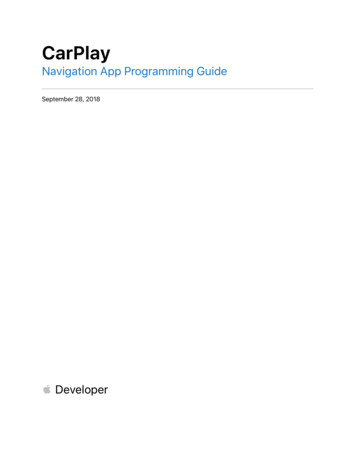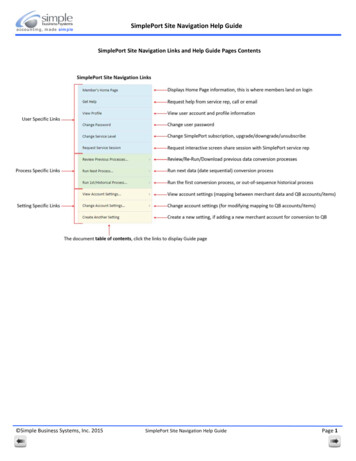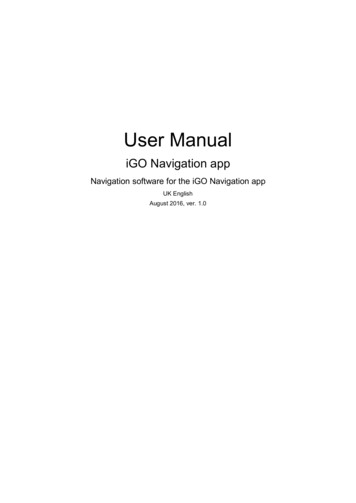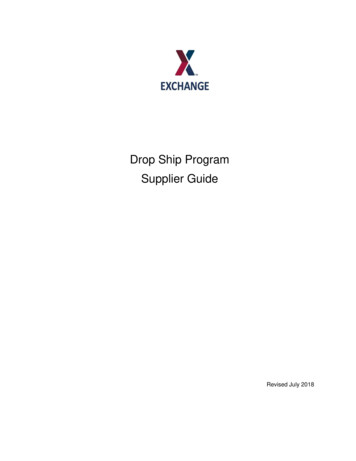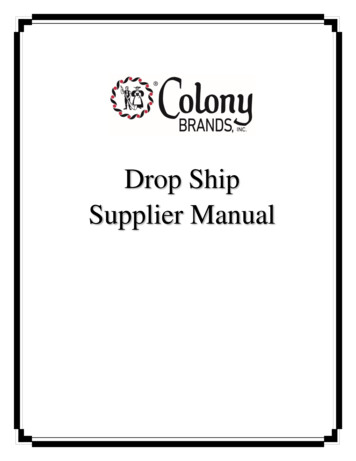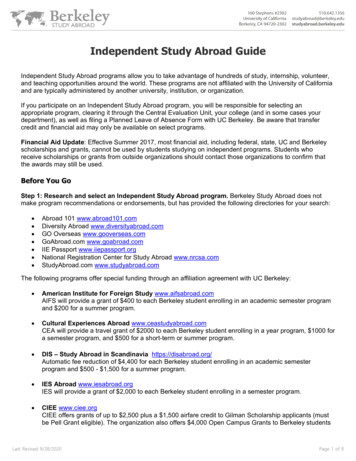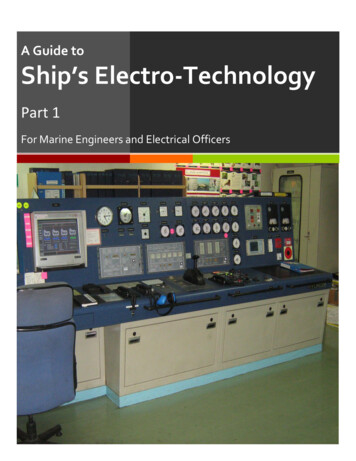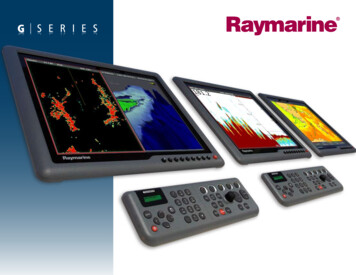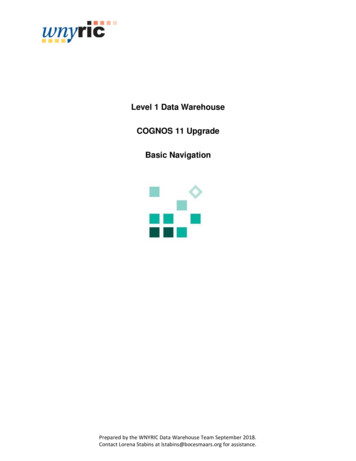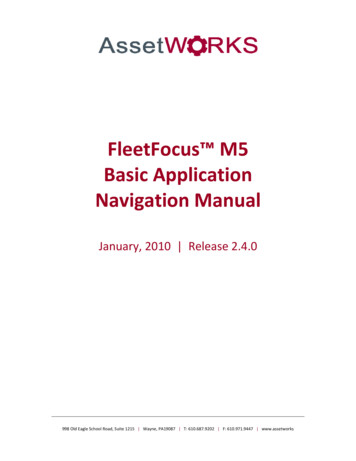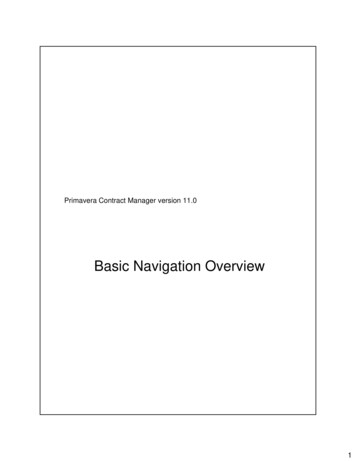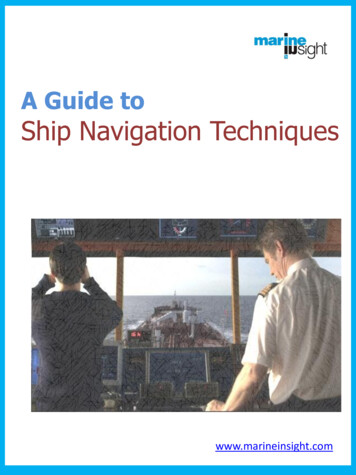
Transcription
A Guide toShip Navigation Techniqueswww.marineinsight.com
Marine Insight A Guide to Ship Navigation TechniquesPublication date August 2012.Author: Karan ChopraPublished by: Marine Insightwww.marineinsight.comGraphic Design: Anish Wankhede(copyright symbol) Copyright 2012 Marine InsightNOTICE OF RIGHTSAll rights reserved. No part of this book may be rewritten,reproduced, stored in a retrieval system, transmitted or distributedin any form or means, without prior written permission of thepublisher.NOTICE OF LIABILITYThe authors and editors have made every effort possible to ensurethe accuracy of the information provided in the book. Neither theauthors and Marine Insight, nor editors or distributors, will be heldliable for any damages caused either directly or indirectly by theinstructions contained in this book, or the equipment, tools, ormethods described herein.www.marineinsight.com
AUTHOR PAGE:About the AuthorKaran ChopraKaran Chopra is an experienced Mariner and a DualCertificate Holder (Engine and Deck). He has sailed as 2ndOfficer for more than seven years on almost all majortypes of vessels. He staunchly believes in spreadingknowledge and therefore loves teaching. In his spare time,he likes writing about his experiences of the sea andconnecting with new people.
TABLE OF CONTENTS:Navigation with Wind . . 4Navigation with Current .9Stopping Distance . .15Use of Thrusters . .21Tug Assistance . .29Berthing Without Tugs . .34Berthing With Anchors . .37www.marineinsight.com
CHAPTER 1:Navigation With WindA navigation or deck officer has to be extremely carefulwhile steering a vessel from its course no matter where theship is – at mid sea, crossing channel, or entering/ leaving aport.The team at the bridge should be efficient enough to sailthe ship in all kinds of waters and weather. One of thenatural factors about which every navigator should be verycareful while steering a ship is – the wind. Vessels such ascontainers and Ro-Ro ships have large freeboard and arethus more affected by winds.// Page 4
A Guide to Ship Navigation TechniquesThis exposed area of the ship isalso known as the windage areafor the effect of wind is moreprominent. The wind effect on thesame ship will be different atdifferent places, depending uponthe draught condition of the ship.A wind with force of 3-4 on theBeaufort scale will have similareffect in light condition as withwind force of 7-8 when the ship isdown to her marks.When ship is at slow speedsduring manoeuvring or near tothe coast, wind direction iseasy to find; but this is not thecase when out at high seas.The direction of the windperceived when standing ondeck is its relative direction.This is the resultant of the truedirection of the wind and thecourse steered by the ship.// Page 5
A Guide to Ship Navigation TechniquesIt is very important for the ship’s navigator to steer theship considering the wind effects so that the ship can besteered efficiently without any difficulty. Following arethe techniques a navigator must master to control a shipunder wind effects.Ship underway with wind from right asternWhen the wind is blowing from the right astern, steeringthe ship becomes easy; however, in case of head wind,the stern part of the ship has the tendency to pay off oneither sides. This is a difficult situation to tackle andgetting the ship back on course is no piece of cake.Such effect is more often seen on ships where theaccommodation area is at the aft region. Moreover, thewind in such case has no braking effect.Note: Given a choice between head wind & wind fromright astern, the head wind is preferred for berthing.// Page 6
A Guide to Ship Navigation TechniquesShip underway with wind from abeamWhen the ship is underway with the wind flowing fromabeam, the steering of the ship is not affected. However,depending on the strength of the wind, the ship driftssideways due to leeway and this has to be accounted forwhile handling the ship.Ship underway with wind on the bowHere again in lighter conditions, the effect on the ship’sstem is larger and this tends the ship’s head to swing awayfrom the wind (leeward). This requires the weather helm(helm on the side of the wind) to be steered continuously.Ship underway with wind on quarterWhen the wind is pushing the ship’s stern away to leeward,the stern tends to swing towards the leeward. The ship istherefore steered towards the wind and the ship is requiredto be given a lee helm.// Page 7
A Guide to Ship Navigation TechniquesVessel under sternwayWhen the ship is going astern, itrarely goes at a great speed. Whengoing astern most ships also tend toswing to the starboard. The effect ofthe wind is therefore a little morecomplex.In ballast condition where the windcatches the bow, which it often does,the stern is pulled into the wind. Thiseffect is quite definite & rapid.All ships turn around a pivoting point.This point is an imaginary referenceand is fixed from observations of theship turning around. It is known thatwhen going astern the pivoting pointmoves aft.Effects of wind can be used -As aBRAKEManoeuvre// Page 8ForTightTurn“This effectmust berememberedwhilemanoeuvringfor anchoring,berthing etc.”ForManoeuvre
CHAPTER 2:Navigation with CurrentIn this chapter we take into consideration atotally different aspect which also plays anequally important role while manoeuvring aship at the sea. Let’s find out how a ship can becontrolled under various effects of oceancurrents.// Page 9
A Guide to Ship Navigation TechniquesThe effects of ocean currentsOcean currents play avery important role inensuring the stability ofthe ship.The effect of currentstherefore must also beconsidered whenhandling ships in waters.Effect of currents areimportant especiallywhen the ship is underthe effect of on-shorewinds, near off-shoreplatforms, whilemanoeuvring in narrowchannels and openseas, or in inland watersor harbours.// Page 10
A Guide to Ship Navigation TechniquesWhen the ship is in harbour or in inland waters and thecurrent is at constant strength and direction, the ship’shandling becomes considerably easier.“Such conditions exist only incomparatively narrow channels ofrivers. Navigational officers should takeinto account different current streamsthat can exist over a small area, withinwhich the vessel has to manoeuvre.”The main difference between currents and winds is thatcurrents affect the ship in definite and predictable ways,unlike the wind does.Even in open waters, when the ship is approaching a rigor a mooring buoy, due allowance should be made forthe effect of the current for a safer manoeuvre.Current from ship’s ahead will reduce the ship’s speedover ground, improve ships response to the rudder, andalso give more time to assess and correct developingsituations.// Page 11
A Guide to Ship Navigation TechniquesShallow Water Effects on Ships – Ship SquatWhen a ship proceeds through water, it pushes thewater ahead. This volume of water returns down thesides and under the bottom of the ship. The streamlinesof return flow are speeded up under the ship, causing adrop in the pressure and resulting in the ship droppingvertically in the water.When the ship drops vertically in the water, it trims bothforward and aft. This overall decrease in the static underkeel clearance, both forward and aft, is called Ship’sSquat. Learn more about Ship’s Squat here.If the ship moves forward at a greater speed in shallowwater, where the keel clearance is 1.0 to 1.5 metres,then there are high chances of grounding at the bow orstern due to excessive squat.// Page 12
A Guide to Ship Navigation TechniquesWhat are the factors that govern Ship’s Squat? The main factor on which the ship’s squat depends isthe ship’s speed. Squat varies approximately with thespeed squared. The blockage factor “S” is another factor to beconsidered while understanding ship squat. Theblockage factor is defined as the immersed crosssection of the ship’s mid-ship section divided by thecross-section of water within the canal or river. The blockage factor ranges from about 8.25b forsuper tankers, to about 9.50b for general cargo ships,to about 11.25 ship-breadths for container ships.The presence of another ship in a narrow river willalso affect squat, so much so that squats can doublein value as the ship pass or cross the other vessel.How to find out if a ship has entered shallow water?1. Wave generation from the bottom of the shipincreases, especially at the forward end of the ship.2. Ship becomes more sluggish to manoeuvre.3. Draught indicators or echo-sounders will indicatechanges in the end draughts// Page 13
A Guide to Ship Navigation Techniques4. Propeller rpm indicator will show a decrease. If theship is in “open water” conditions i.e. without breadthrestrictions, this decrease may be up to 15% of theservice rpm in deep water. If the ship is in confinedchannel, this decrease in rpm can be up to 20% of theservice rpm.5. There will be a drop in ship’s speed. If the ship is inopen water conditions this decrease may be up to35%. If the ship is in a confined channel such as a riveror a canal then this decrease can be up to 75%.6. The ship may start to vibrate suddenly. This isbecause of the water effects causing the natural hullfrequency to become resonant with another frequencyassociated with the vessel.7. Any rolling, pitching and heaving motions will bereduced as ship moves from deep water to shallowwater conditions. This is because of the cushioningeffects produced by the narrow layer of water under thebottom shell of the vessel.8. The appearance of mud cloud will be visible in thewater around the ship’s hull when the ship is passingover a raised shelf or a submerged wreck.// Page 14
A Guide to Ship Navigation Techniques9. Turning Circle Diameter (TCD) increases. TCD inshallow water could increase 100%.10. Stopping distances and stopping time increase, ascompared to when a vessel is in deep waters.11. Effectiveness of the rudder helm decreases.“The vessel'sturning circlewill increaseand the rate ofturn willdecrease due tosquat effect”// Page 15
CHAPTER 3:Stopping DistanceEvery vessel shows different characteristics when it comesto the distance covered when a stop signal is given due todifference in dimensions, loading and ballast conditions.// Page 16
A Guide to Ship Navigation TechniquesIt is very important for a navigating officer to learn theprinciples of passage planning and understand his ship’scharacteristics as a small mistake in understanding may leadto collision, grounding or other kind of mishaps.Stopping distance of shipsAs we all know, ship like any other transport utility does nothave brakes to make them stop immediately. When theengine is given stop order, the ship will continue moving inthe same direction due to inertia and will come to stop aftermoving for some distance.Every ship has two different stopping distances–Inertia Stop// Page 17Crash stop
A Guide to Ship Navigation TechniquesAs described above, when the engine of the ship is stopped,the ship will continue moving in the same direction for somemore distance due to inertia. Here no astern command isgiven (used to produce “braking effect” for ships), and henceship will travel more distance in the inertia stop method.Inertia StopAs described above, when the engine of the ship is stopped,the ship will continue moving in the same direction for somemore distance due to inertia. Here no astern command isgiven (used to produce “braking effect” for ships), and henceship will travel more distance in the inertia stop method.Crash StopCrash stop is usually the term used when the ship has tosuddenly stop in emergency situation. Here the engine,which is moving in an ahead direction is given an order forfull astern, leaving the rudder in the mid ship position tostop the ship within minimum distance and shortest possibletime. To know the complete procedure of crash stoppingread – crash manoeuvring.// Page 18
A Guide to Ship Navigation TechniquesIn general operation i.e. berthing or departure of the shipfrom port or manoeuvring through channel or narrowpassage, the above two methods are combined for a swiftnavigation of the ship i.e. in between giving an astern kick tostop and slowing down the ship’s speed for bettermanoeuvring.“The stopping distance data andchart are given in sea trials of theship and are made handy onbridge for reference.”The data may differ when used due to variation in weathercondition, ships loading, stability and other factors; however,deck officers can compare the trail data and make use of it inpractical situations.// Page 19
A Guide to Ship Navigation TechniquesFew Practical Examples Depending upon the loading condition and the speed ofthe ship, the stopping time will be different when thesetwo conditions are changed. Also ships fitted with diesel machinery will havestopping distances approximately 70% of those fittedwith Steam Turbine machinery. When the ship’s hull has been due cleaning (dry dock) forlonger time, the stopping distance and time will be lessas compared to when the ship is just out of dry dock. Thisis because the hull resistance is more in ships with drydock done long ago. The wind direction and sea condition also plays animportant role as wind and waves acting from behind theship will increase the stopping distance and vice versa. It is important for a navigation officer to know thesurrounding of the ship and how the ship will react tochanges in speed and loading conditions.// Page 20
CHAPTER 4:Use of Thrusters“Thrusters are typeof propellers,smaller in size,which help in bettermanoeuvrability ofthe ships at lowerspeeds.”Thrusters are fitted normally in the fore and aft parts ofthe ship. These points of location help to create a turningeffect and assist the ship in changing the lateral directionduring berthing or departing the jetty.The bow thruster is solely introduced in ships to avoid, orin better words, to minimize the use of expensive tug boatsas most of the port state authorities around the world havecompulsory requirements to use tug boats for safetypurpose.// Page 21
A Guide to Ship Navigation TechniquesIt is extremely important that the navigating officer onbridge understands the significance of assisting machinerysuch as bow thrusters during the most critical operationperformed by ship and its staff – The berthing of the ship.Following points must be considered while berthing theship using bow-thruster: While using thrusters ensure that the ship’s speed in notmore then 4 knots as above this the effect caused bythrusters would reduce. This happens because of themerging of the thruster stream with the general waterflow on the side of the ship’s hull due to its forwardmovement. When using a single forward thruster, it is important toconcentrate more on the astern as the bow can becontrolled by the forward thruster. In such situation,always prioritize to berth or bring the astern of the shipalongside first and then control the ship’s bow. When turning the ship with two thrusters located at foreand astern, the pitch of the thrusters must be opposingeach other, creating a turning moment. Massive cargoships must be assisted by the tugs at the astern part tocontrol the stern movement.// Page 22
A Guide to Ship Navigation Techniques When using the bow thruster while the ship is at stop,the astern part will act as a pivotal point. If the thruster isput in the port side, the ship will turn in the samedirection. When using the thruster with ship running headway, thethruster’s effect will be slightly less as both the pivotaland thrusting points are now in forward position. When using bow thruster with ship travelling sternway,the pivotal point will be the ship’s stern, which will turnin the same direction as that of the thruster and act as arudder. It is very important to have an efficient steering gearsystem as the ship turning by use of thruster is highlydependent on how responsive the rudder (steering gearsystem) is. Thrusters are used while anchoring the ship. They assistin turning the bow of the ship away from falling anchor toavoid damage by the anchor chains.// Page 23
CHAPTER 5:Tug AssistanceTugs are important for both sides involved inthe manoeuvring operation of the ships i.e.the ship’ staff and the port.// Page 24
A Guide to Ship Navigation TechniquesUse of TugBy Ship’s StaffBy Port �Safety is the most important aspecttaken into consideration for using tugsin port and ship berthing operations.”// Page 25
A Guide to Ship Navigation TechniquesSelecting the Number of TugsTugs are extremely helpful for manoeuvring, but aremonetary burden on ship owners as each tug taken forassistance is charged a handsome amount. However, theyensure the most important factor - safety of the ship and theport, which compensates the monetary part.The selection of the number of tugs depends on variousfactors:Port RequirementShip and berth sizeWindage area of the shipAvailability of ThrustersPower of TugUnder keel clearance of shipsManoeuvring characteristic and power of ship’s engine// Page 26
A Guide to Ship Navigation TechniquesDuring operation, tugs are usedat slow speed to prevent forcesbetween the tug and the shipfrom becoming large enough tocapsize the tugs. It is veryimportant to remember thatthe effectiveness and safeoperating condition of tugsdepend on the distancebetween the point of contactand the ship’s pivot point.Precaution to be taken during Tug Operation Ship must be operated at low speed (below 5 knots) toeffectively use the tugs. Master of the ship and the Tug operators must discussthe location of tug attachment before the operationstarts as the turning lever is decided by the position ofthe tugs. Those operating the ships must have knowledge aboutthe operational capabilities of different kind of tugs.Conventional tugs are less flexible than water tractortugs.// Page 27
A Guide to Ship Navigation Techniques Always have a lookout on the tug from the ship and givesufficient time to the tugs for attaching, repositioning,and pulling/pushing operations. Remember to decide and control the ship’s speed whenthe tug attached is leading forward as it may result inincrease in ship’s speed. Keep checking the space limitations while the ship isclose to the jetty or other ships. The forces generated by tugs’ propeller at stern or bowmay cause the ship to move away from the direction ofpull. When the ship has headway with two tugs attached,one forward and one aft, the aft tug will have moreeffect than the forward one because the distance fromthe after tug connection to the ship’s pivot point isgreater. If both tugs are applying the same power, theresult will be a swing of the ship in favour of the aft tug.// Page 28
CHAPTER 6:Berthing Without TugsThe navigating officer of the ship must know how tocontrol a ship in different types of berthing conditions,keeping in mind the safety of the ship and its crew.// Page 29
A Guide to Ship Navigation TechniquesThere can be situations when there is no availability oftugs for berthing of ships. In such cases, the navigatingofficer must be skilful to steer the ship and berth her to itsassigned jetty.The three important aspects important for berthing ofships without tugs are:RudderShip’s Speed// Page 30Thruster
A Guide to Ship Navigation TechniquesThe bridge team must consider the factor of wind andcurrent carefully while steering the ship as the additionalsupport function- the tugs is not available.There are two main scenarios for berthing a ship (for aFixed Pitch Propeller, right handed single screw) withouttug assistance Port Side Berthing Starboard side berthingPORT SIDE BERTHINGWhen the ship is tied to the jetty from her port side, theship is moved towards the berth at certain angle. Theastern thrust thus generated is used to stop the ship’smotion and to turn the bow towards starboard, which willturn the ship’s astern to port side.As soon as the ship is parallel to the berth, the ship can becarefully and slowly manoeuvred to its drafted position byastern kick, which provides the transverse thrust. Theactual operation will highly depend on the berth positionand available space.// Page 31
A Guide to Ship Navigation TechniquesSTAR BOARD SIDE BERTHINGIt is important to balance the forward speed of the shipagainst the astern power needed to stop the same. Thegreater the forward speed, the greater is the asternpower required to stop the ship. This result into greatereffect of the transverse thrust, which brings the ship’sbow close to the berth and throw the stern off.Aim to approach the berth by keeping the ship parallel.The effect of transverse thrust will swing the bowtowards the berth.Do Not Increase the Approach speedShip can hit the berth with her bow before stopping, orthe large astern movement used to stop the ship and theresulting transverse thrust can cause the stern to hit theberth.Ahead kick near the berthIf a sharp kick ahead is made close to the berth, theship’s bow can strike the berth.// Page 32
A Guide to Ship Navigation TechniqueIgnore the lateral motionWhen approaching port-side to the berth, the ship’slateral motion is to the port. Insufficient awareness oflateral motion can cause a ship to land heavily againstthe berth.Stop too farIf the ship is stopped with her bow at a distance from theberth, it will be difficult to position it close to the jetty. Insuch situation, move the ship laterally and swing therudder to port for bringing the bow close to the jetty.However, note that this will only cause her to move in alateral direction, away from the berth as lateral motion isalways at right angles to the direction of motion andaway from the direction of turn. This will make theoperation more complex and longer.If berthing against a knuckle, it is important to land flatagainst the straight part of the quay, and not on theknuckle.// Page 33
CHAPTER 6:Berthing With Anchors“Anchors areconsidered assecondary butimportantberthing aid andare normally usedwhen no tugs areavailable or in theabsence of bowthrusters.”During all manoeuvring and harbour operations, one team isalways assigned to anchor operation for emergency stop ofthe ship (during engine or steering failure).// Page 34
A Guide to Ship Navigation TechniquesDredging anchorsDredging anchor is a popular technique used tomanoeuvre large ships in constrained waterways. A largeanchor is lowered from the bow of the ship to just touchthe bottom without getting anchored or set. The ship’sbow is then held stationary by the anchor and the shippivots via the stern.A bow anchor can be dredged from a ship going forwardor astern. To overcome the anchor’s drag, propulsivepower is used giving good steering at low speed. Whengoing forward, corrective action will be needed toprevent the bow from swinging to port or starboard. Theintention is for the anchor to drag and not to dig in. If theanchor does dig in, it could cause the ship to stop andnecessitate breaking the anchor out again.“Digging in” can also damagethe ship, anchor, or windlass. Itis therefore important to use aslittle cable as possible typically a length of cable thatis between one and a half ortwo times the depth of thewater.// Page 35
A Guide to Ship Navigation TechniquesEmergency anchoringDuring an emergency while manoeuvring, emergencyanchoring is used to stop the ship as soon as possible toavoid collision and grounding. When this is done, first theanchor is dragged and after building up its holding power,the anchor will dig and start the breaking effect for the ship.Extreme care must be taken not to have excessive forces orpressure in the anchor winches and machinery or else itmay lead to accidents.“Local knowledge regarding the nature andcondition of the seabed is important to avoiddredging in an area where the bottom is foul.”// Page 36
CHAPTER 7:Safe Manoeuvring - ConclusionFor a Safe and smooth berthing or manoeuvring, alwaysknow and prepare beforehand the following: Passage planning Weather condition Water depth and area for ship’s movement Types of tug used Position for tugs Keep ready Emergency anchors Pre-checked and well operational mooring machinery Port / ship communication“Ship Navigation is more of an art which is developedthrough experience rather than just knowledge. Whenboth experience and knowledge are merged in the rightmanner, you can definitely master the ship’s navigationtechniques.”// Page 37
Please feel to share this guide with your friends and colleagues.For more interesting articles on ship navigation and operations, visitwww.marineinsight.comImage credits: noaaehowcdnsvacrowleytoledoblade chettinaditusozluksailingwithattitude
When a ship proceeds through water, it pushes the water ahead. This volume of water returns down the sides and under the bottom of the ship. The streamlines of return flow are speeded up under the ship, causing a drop in the pressure and resulting in the ship dropping vertically in the water. When the
